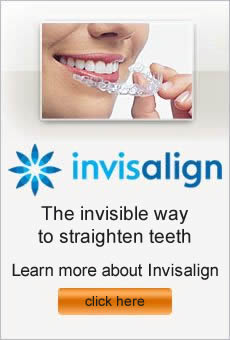Getting braces can be quite an adjustment. Because treatment typically lasts for 18 to 24 months, you need to plan on having your braces with you for some time. Knowing what to expect, how to care for braces, and other helpful information will ensure that you maximize your orthodontic treatment.
Eating and Braces
In general, you can eat plenty with braces. You do, however, need to avoid sticky foods like caramel, chewy foods like licorice, hard foods like nuts, and foods you have to bite into like corn on the cob. Feel free to much out on yogurt, pasta, diced chicken, green beans, bananas, and other easy-to-chew options.
Dealing with Discomfort
After the initial placement, your teeth and mouth may feel tender, which is perfectly normal. This discomfort will pass in a couple of days, after you get used to the braces. You may also experience some soreness after an adjustment.
Loose Brackets and Wires
Sometimes, wires and brackets become dislodged or break. If this happens, contact your orthodontist right away. You can place wax over the broken area to prevent irritation in your mouth.
Playing Sports
Having braces won’t stop you from going out for basketball, football, or your favorite sport. To protect your mouth, most orthodontists recommend a mouth guard, which covers your teeth and gums.
Caring for Your Teeth
During orthodontic treatment, it is really important that you practice good oral hygiene. Braces can make you more susceptible to problems like tooth decay and gum disease. Remember to brush after each meal, floss once a day, and see your dentist for routine exams.
We care about your smile at our Sherman Oaks, CA orthodontic office – Mehdi Fotovat, DDS.
If you think your child needs braces, you may feel a bit overwhelmed. Most parents have questions about costs, timing, and other issues with treatment. The following questions and answers will help you gather the information you need to make the best decision for your child. Once you start orthodontic treatment, your orthodontist can provide clarity and guidance.
When should I take my child to the orthodontist?
According to the American Association of Orthodontists, children should have an orthodontic evaluation by age seven. Certain problems are easier to treat while children are still growing.
Will my child need to have teeth extracted?
New technology and advanced procedures mean that most of the time, teeth are not extracted for orthodontic treatment. Your orthodontist will know more after a thorough examination.
Can my child still play an instrument or participate in sports?
Definitely. Your child may need a little time to adjust to playing a wind or brass instrument with braces, but the treatment shouldn’t inter with musical participation. For athletes with braces, we recommend a mouth guard for protection.
How long will treatment last?
Every case is different. The time frame for orthodontic treatment depends on many factors including the severity of the issue, patient cooperation, and how quickly teeth move. An average treatment course for braces is about two years.
Will my child’s teeth move after treatment?
Once the braces come off, it is important for your child to wear his or her retainer as instructed by the orthodontist. Though teeth shift some as we age, the retainer should help stabilize the position of the teeth and give your child a gorgeous smile for life.
Dr. Mehdi Fotovat is an Orthodontist located in Sherman Oaks CA. – Burbank Orthodontist – WebBraces.com
Did you know that 25 percent of patients seeking orthodontic treatment are adults? You are never too old to enjoy the benefits of a beautiful smile. Not only will straightening your teeth boost confidence, but it will also improve your oral health because crooked teeth are harder to brush and floss properly.
If you are considering orthodontic treatment, these basics points will help you make an informed decision about your options.
How is adult treatment different than orthodontics for kids?
Because older patients are no longer growing, orthodontic treatment at this point is designed help adults attain a vibrant, healthy smile.
Do I have to wear metal braces?
Thanks to advances in orthodontics, adults have more discreet choices for straightening their teeth. Ceramic brackets, lingual braces, and Invisalign clear aligners allow you to achieve an attractive smile without compromising your mature image.
My teeth have been crooked for years. Why should I consider treatment now?
Your smile will not only look better, but your teeth and jaws will function better if they are in proper alignment.
How long will treatment take?
Though it is difficult to predict the exact time frame, your orthodontist will give you an estimated time table based on your case and expected progress. The average time for treatment is 18 to 24 months.
Can orthodontic treatment help with jaw pain?
If misalignment is the cause, correcting your bite should help with the discomfort. If your pain is caused by clenching and grinding at night, your orthodontist can fit you for a night guard.
It’s time to schedule a visit to our Sherman Oaks, CA orthodontic office – Mehdi Fotovat, DDS.
As you check out orthodontic treatment for yourself or a family member, it’s important to make sure you have accurate information. Plenty of faulty ideas and folklore have been heralded as orthodontic gospel. Get your facts straight as you check out this list of common orthodontic myths:
Myth: I can have my family dentist straighten my teeth
Reality: Just like people visit a neurologist, not a family doctor, for issues relating to the brain, you should see an orthodontist to correct alignment and bite problems. Beyond regular dental school, orthodontists complete another two to three years of advanced training relating to the function and fit of teeth.
Myth: Only kids need braces.
Reality: A little less than 20 percent of orthodontic patients are 18 years or older. Not only will a straight smile look fantastic, but it also makes brushing and flossing easier, which can improve oral health.
Myth: I can download songs onto an iPod off signals from my braces that link to the Internet.
Reality: Though this would be a great selling point for young patients, it’s not possible at this time.
Myth: Orthodontic treatment takes two years and is very painful.
Reality: Braces aren’t one-size fits all. Treatment time depends on your specific case, ranging from a few months to a couple of years. As for discomfort, you may experience some initial soreness, but after the adjustment period, most people have few complaints.
Myth: All braces are ugly and embarrassing.
Reality: While traditional metal brackets aren’t the most appealing choice, newer options exist for less noticeable orthodontic treatment. Many kids and teens choose brightly-colored wires and brackets to add flare to their orthodontia. Adults who want to preserve their professional images may want to consider Invisalign clear braces, lingual braces that go on the back of the teeth, or ceramic brackets.
Mehdi Fotovat, DDS. Sherman Oaks California orthodontics – we care about you and your smile!
Oral hygiene is always important, but when you have braces, it’s even more critical. Because food can easily get trapped between braces, you may be more prone to gum irritation, bad breath, teeth discoloration, and cavities. Following these tips will help keep your mouth healthy during orthodontic treatment:
• Take it tooth-by-tooth. Make sure you really concentrate on every tooth, spending at least 10 seconds on each one.
• Angles matter. Position your brush so that it’s angled down toward the area where the tops of your teeth and braces meet. When you brush the bottoms of your teeth and braces, angle the brush upward.
• Cover the whole area. Most people remember to brush the front of their teeth, but may neglect the chewing surfaces or tongue-side of teeth.
• Do the two-step. During orthodontic treatment, you need to brush right after meals. The longer food stays trapped in your braces, the greater risk for plaque formation and tooth decay.
• Plan ahead. Carrying a toothbrush and toothpaste with you will make it easier for you to brush any time you finish eating.
• Pieces and parts. If you have head gear or rubber bands, remove these items before you brush.
• Think fluoride. Preventing cavities during treatment is critical, so choose fluoride toothpaste; a fluoride mouthwash wouldn’t hurt.
• Don’t forget the floss. Though flossing is more difficult with braces, you need to make the extra effort. Some people have no trouble with regular floss, but products like floss threaders can make it easier for you to reach under the wires and get the job done.
• See your dentist. You need to perform home oral care, but professional cleanings will help keep your teeth and gums healthy, so don’t skip your regular appointment.
Keeping your smile beautiful and healthy at our Sherman Oaks, CA orthodontic practice – Mehdi Fotovat, DDS.



